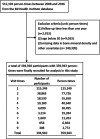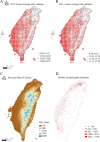Environmental and personal factors for osteoporosis or osteopenia from a large health check-up database: a retrospective cohort study in Taiwan
- PMID: 35948894
- PMCID: PMC9367101
- DOI: 10.1186/s12889-022-13938-8
Environmental and personal factors for osteoporosis or osteopenia from a large health check-up database: a retrospective cohort study in Taiwan
Abstract
Background: Osteoporosis is an important public health issue in aging societies because of its associated morbidity, mortality, and decreased quality of life. The study aims to identify the association of low bone mineral density, including osteoporosis and osteopenia, with environmental and personal factors.
Methods: The data of participants aged ≥ 20 years with multiple visits were obtained from a health check-up database in Taiwan from 2008 to 2016. Multivariable logistic regressions were performed to identify the selected factors associated with low bone mineral density for multiple visit data.
Results: A total of 194,910 participants with 359,943 visits were included in this study. The prevalence of low bone mineral density (BMD) in the study population was 10.6% (n = 20.615). Older women, ever and current smokers (odds ratio (OR) = 1.04 [95% confidence interval (CI) = 1.01, 1.08]), or participants who were underweight (OR = 1.72 [1.64, 1.81]), consumed a vegetarian diet (OR = 1.32 [1.25, 1.39]), or had higher triglyceride levels (OR = 1.04 [1.01, 1.06]) were significantly associated with a higher risk of low BMD. Participants who had higher educational years (OR = 0.43 [0.41, 0.46]), higher physical activity (OR = 0.93 [0.89, 0.97]), appropriate sleep duration and better quality (OR = 0.98 [0.97, 0.99]), dairy intake (≥ 1 slice of yogurt or cheese/week, OR = 0.97 [0.95, 0.99]), higher uric acid (OR = 0.93 [0.91, 0.95]), higher walkability (OR = 0.997 [0.995,0.999]), and higher solar radiation exposure (OR = 0.997 [0.97,0.99]) were significantly associated with a lower risk of low BMD.
Conclusion: Interventions in different directions, such as having better health behaviors, increasing sun exposure, and residing in a highly walkable environment, are beneficial for reducing the risk of low BMD.
Keywords: Health behaviors; Osteoporosis; Solar radiation; Walkability.
© 2022. The Author(s).
Conflict of interest statement
Ping-Chen Chung and Ta-Chien Chan declare that they have no conflict of interest. The funders had no role in the design of the study, in the collection, analyses, or interpretation of data, in the writing of the manuscript, or in the decision to publish the results.
Figures
Similar articles
-
Bone mineral density of vegetarian and non-vegetarian adults in Taiwan.Asia Pac J Clin Nutr. 2008;17(1):101-6. Asia Pac J Clin Nutr. 2008. PMID: 18364334
-
Gender-specific prevalence and influencing factors of osteopenia and osteoporosis in Chinese rural population: the Henan Rural Cohort Study.BMJ Open. 2020 Jan 12;10(1):e028593. doi: 10.1136/bmjopen-2018-028593. BMJ Open. 2020. PMID: 31932385 Free PMC article.
-
Utilization of DXA Bone Mineral Densitometry in Ontario: An Evidence-Based Analysis.Ont Health Technol Assess Ser. 2006;6(20):1-180. Epub 2006 Nov 1. Ont Health Technol Assess Ser. 2006. PMID: 23074491 Free PMC article.
-
Association between bone mineral density and benign paroxysmal positional vertigo: a meta-analysis.Eur Arch Otorhinolaryngol. 2019 Jun;276(6):1561-1571. doi: 10.1007/s00405-019-05345-4. Epub 2019 Apr 27. Eur Arch Otorhinolaryngol. 2019. PMID: 31030242
-
Osteoporosis in people with intellectual disabilities: a review and a brief study of risk factors for osteoporosis in a community sample of people with intellectual disabilities.J Intellect Disabil Res. 2011 Jan;55(1):53-62. doi: 10.1111/j.1365-2788.2010.01346.x. Epub 2010 Dec 3. J Intellect Disabil Res. 2011. PMID: 21129056 Review.
Cited by
-
Bone mineral density parameters and related nutritional factors in vegans, lacto-ovo-vegetarians, and omnivores: a cross-sectional study.Front Nutr. 2024 Jun 11;11:1390773. doi: 10.3389/fnut.2024.1390773. eCollection 2024. Front Nutr. 2024. PMID: 38919395 Free PMC article.
-
Potential Association of Osteoporosis and Not Osteoporotic Fractures in Patients with Gout: A Longitudinal Follow-Up Study.Nutrients. 2022 Dec 28;15(1):134. doi: 10.3390/nu15010134. Nutrients. 2022. PMID: 36615792 Free PMC article.
References
Publication types
MeSH terms
LinkOut - more resources
Full Text Sources
Medical



